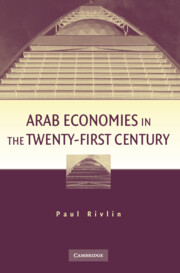4 - Comparative Economics
The Arab World, East Asia, and Latin America
Published online by Cambridge University Press: 05 June 2012
Summary
Introduction
The economic development of the Arab world during the last fifty years contrasts sharply with that of East Asia and has in some respects paralleled that of Latin America. In 1960, per capita income levels in nine poorer Arab states (the non-oil-rich states plus Iraq) were about 17 percent higher than those in East Asia. Incomes in South America were 40 percent higher than in the Arab nine and about 60 percent higher than in East Asia. Since then, a huge gap in favor of East Asia has developed. Despite differences of opinion about how East Asia developed, there is an agreement about some of the causes. An examination of the causes of success in East Asia and some of the problems facing countries in Latin America will throw light on the problems of development in the Arab world. Figure 4.1 shows that since 1980, gross domestic product (GDP) per capita growth in fifteen Latin American countries has paralleled that in fifteen Arab states, while that in the eight East Asian countries accelerated much more rapidly. In the nine Arab states the pattern of growth was similar but the level of income was much lower than in the Latin American group. The increase in the value of oil production had a much larger effect on Arab economies than on those in any other part of the world.
Figures 4.2 to 4.4 provide details of the growth of national income, population, and national income per capita since 1960.
- Type
- Chapter
- Information
- Arab Economies in the Twenty-First Century , pp. 61 - 94Publisher: Cambridge University PressPrint publication year: 2009



